In this chapter, we concentrate on newspapers, magazines and online publications, looking at how they can use pictures to tell the news. In the following chapter we discuss various kinds of graphics and how to caption pictures.
Please Note: Most of the photographs used in The News Manual Online are taken from the original three-volume book. They were screened for the printing technology in use at the time and are, therefore, grainy by comparison with modern digital photographs. I have included them partly because they were taken and selected by Peter Henshall himself. We hope eventually to build an additional Resource to share examples of good and bad news pictures sent in by journalists. |
________________________________________________________
Most print media use a combination of words and pictures to tell the news, but some only use words. If you have ever seen a newspaper with no pictures, you will know that it does not look attractive; it does not make you want to read it. It looks as though it will be hard work, and readers are therefore put off. It is also limited in its ability to tell the news accurately.
When we talk about "pictures", we are usually talking about photographs, but there are other kinds of pictures, too. Good drawings, paintings and other graphic work also work well as news pictures. We shall consider those in the next chapter.
Why do we need news pictures?
There are three main reasons why newspapers need news pictures.
To brighten the page
A page without a picture is just a slab of grey text. It looks boring and many people will not bother to read what is written on it.
That is a pity if some of those stories are well researched and well written, but it is true. The readers who pay money for a newspaper expect their job to be made easy for them. They expect the news to have been sorted out into big stories and little stories, to have been written clearly, and to be presented in a way which is easy to read.
Newspapers without pictures do not make the news easy to read. They make life hard for the readers. The newspaper's journalists are not doing their job properly.
To tell the news
As we saw in Chapter 1: What is news?, news is something which is new, unusual, interesting, significant and about people. It is obvious that new, unusual, interesting and significant things about people can be communicated by pictures as well as by words.
Not all stories will be ideal for pictures. Some will be told more easily in words than in pictures, while other stories may be told with one picture more easily and more clearly than in many words.
There is an old saying in English that "one picture is worth a thousand words". That can be true, but only if it is the kind of story which is suitable to be told by a picture, and only if it is a good picture. We shall look in a moment at what makes a good news picture.
Pictures can sometimes tell the news just by themselves, with a caption to say who the people are and where the event is taking place. At other times, the picture may go with a story, to work as a team with the words. In either case, a news picture must always leave the reader knowing more than he did before. It must carry information.
To show what it looks like
Only a very gifted writer can use words in a way which lets the reader visualise exactly what a scene is like. Not every reporter can write as well as that.
A picture can let the reader see what a person, or a place, or a building, or an event looks like.
In societies which do not have television, newspaper photographs are probably the only way that most people can know what these things look like. They may be the only way that people outside the capital city will know what their own leaders look like. Even in societies with television, some areas of the country and some levels of society may have no access to it, and many of the programs may be imported from overseas. The newspapers still have an important job to let readers know what their own news looks like.
^^back to the top
What makes a strong news picture?
A strong news picture has to be about the news. That is, it has to be about something which is new, unusual, interesting, significant and about people. To that extent, it is no different from a news story. However, news pictures also need three other qualities:
Life
To the photographer, a picture assignment may seem dull. It may just seem like yet another cheque presentation, or yet another graduation day, or yet another retirement.
To the people involved in the story, though, each of these is a big event - the culmination of months of fund-raising, the fruit of years of study or the end of a lifetime's service. It is the news photographer's job to feel the same excitement which the people involved in the story feel, and to convey that through the picture to the readers.
If the people being photographed look alive and involved in the subject of the photograph, then the photograph will have life.
Relevant context
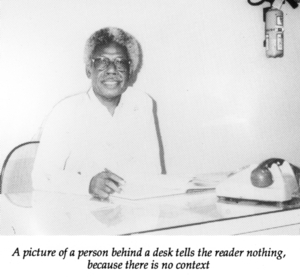 A photograph of a man behind a desk tells us nothing, and no newspaper should ever publish such a picture.
A photograph of a man behind a desk tells us nothing, and no newspaper should ever publish such a picture.
Some people sit behind desks because they are business people, running companies which produce soft drinks - photograph them in the factory, surrounded by bottles of soft drink.
Some people sit behind desks because they are head teachers, running schools - photograph them in the school grounds, surrounded by students.
People sit behind desks for many reasons, and it is the reason which matters, not the desk.
Also, it has to be a very unusual desk for the picture to have any interest for the reader.
A desk with a phone and some papers on it is very boring.
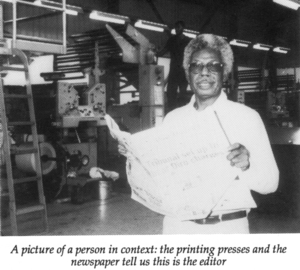 News pictures should always try to capture this context, the job which the person does, or the reason why they are in the news. If a schoolteacher is in the news because they have won a painting competition, then the relevant context would be the painting. A photograph of them teaching would not provide the correct context.
News pictures should always try to capture this context, the job which the person does, or the reason why they are in the news. If a schoolteacher is in the news because they have won a painting competition, then the relevant context would be the painting. A photograph of them teaching would not provide the correct context.
However, a photograph of the teacher painting, surrounded by the students, might be the complete news picture.
In the case on the right, the man is an editor, so show him doing something special to his job.
Meaning
Every news picture must earn its space on the page. That means that it must tell the story clearly, without needing people to read the story first in order to understand what the picture is all about. In other words, every news picture must have meaning.
A picture of a man pointing at a broken window means nothing. If this is a man whose house has been broken into, by the thieves breaking a window and climbing in, then the story is about the way he feels, as well as the damage done. The picture should show his anger, or distress, in his expression and gestures; behind him and to one side can be the broken window; all around him may be the mess which the thieves left behind. In this way the picture can have meaning to the reader.
^^back to the top
Types of news picture
It is not possible to give a complete list of types of news picture, any more than it is possible to give a complete list of types of people. People come in all sorts of shapes, sizes and characters; so do news pictures.
The list which follows is just a guide to the most common types.
Some news pictures will fit into more than one category - a portrait of a person may well be humorous, for example. And there will always be good photographers who can produce good pictures which book authors cannot fit into any category at all. That is what makes journalism so interesting.
The happening
There are all sorts of news story, but the big one is the thing which just happened. Perhaps there was an unusual act of nature - an earthquake, a cyclone, an eclipse of the sun. Perhaps there was a man-made drama - a murder, a robbery, a demonstration, a parade. Whatever happened, it was new; and if it was unusual and interesting, then it was news. A photograph of it is just what a newspaper editor wants.
A photograph of a happening helps the readers in many ways. It provides proof that the event really happened, since the readers can see it with their own eyes. It also takes the readers there, and lets them see the setting in which the event happened. In this way, it helps the words to tell the story, by making clear what they mean.
The epitome
An epitome is something which shows, on a small scale, exactly what something larger is like. For example, a photograph of one student with her head buried in a book might epitomise all the studies being done by all students, and could be a strong news picture as the time of national examinations comes near.
Epitomes are important to news pictures. It is impossible for the human mind to imagine 10,000 people starving to death, or 500 refugees being turned back at a border, or 30,000 miners on strike. These numbers are too vast, and our minds cannot cope.
What people can understand is one thin mother, with no milk in her breasts, watching her baby starve to death.
They can understand the despair of one refugee as the door of hope is shut in his face.
They can understand the hopes and fears of one striking miner, as he balances the desire to stand up for what he considers to be his rights against the need to provide for his family.
In each case, by reducing the vast scale of the story to the human scale, the story gains in emotional power. The epitome is the picture which shows in one person what the story actually means to 500, 10,000 or 30,000. It turns statistics into people.
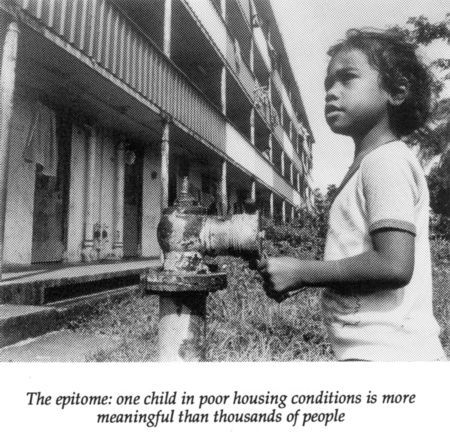
There are also pictures which epitomise situations, in that each part of the picture stands for something bigger. For example, when the Soviet Union sent its army to occupy Czechoslovakia in August 1968, and end the liberal reforms of the Dubcek government, people went out on to the streets of Prague to protest. One memorable photograph showed a young man, still wearing his pyjamas, standing in front of the gun of a Russian tank baring his chest defiantly. The picture summed up the whole situation - the weak humanity of Czechoslovakia being defeated by the metal inhumanity of Russia, but still refusing to accept it. It was a brilliant and memorable epitome.
People
News is about people. It is about things which people do, and things which happen to people. To tell the news, we need to let the readers know who those people are and what they are like.
A picture can do this, if it shows the person's character and the person's context. If the news story is about a man's house being burned down, then we do not want a picture of him smiling: he needs to look sad. He needs to be photographed either in the burned remains of his house, or on the beach where he has to sleep now, or in whatever other context tells the story.
Revelations
Most of our readers see only a few places and meet only a few people in their everyday lives. They do not see a lot of what goes on around them, because it happens in places which they never visit.
There are many other things which most of our readers do not see because they do not want to see them, even though they may be happening in places which they visit regularly - beggars on the street, people looking in rubbish bins to find food, pickpockets and car thieves.
It is part of the job of all the news media to reveal to their readers or listeners what their society is like, and newspapers in particular can publish pictures which force people to see clearly the society they live in.
These pictures may show that crime is committed, that some people live in poor conditions in squatter settlements or shanty towns, that there is social injustice, that there is fighting going on between rival clans in remote parts of the country.
All this may sound very negative, but it is only possible for things which are wrong to be put right when people know about them. When you sweep out a room, the first job is to get all the dirt out from under the furniture into the middle of the room. Only then can it be cleaned right out of the door. In the same way, journalists often need to bring the dirt of society into the open, so that it can be cleaned up.
Not all revelations need to be negative, though. It is just as valuable to make your readers look for the first time at the life of a person or a family which overcomes difficulties - perhaps dealing with physical handicap, or finding ways to make money when there are no jobs available, or getting on with life while tribal fighting is going on all around.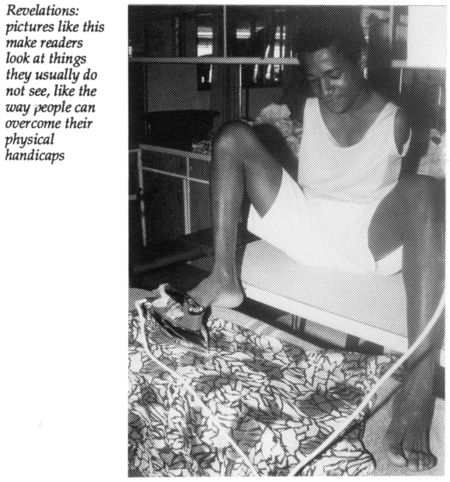
Humour
A newspaper without a sense of humour is missing out on an important part of life. People enjoy a joke, and they will like a newspaper more if it can see the funny side of life as well as the serious side.
Pictures can often be funny by bringing together things which are not usually seen together, or by using contrasts of extreme sizes.
Pretty pictures
People do like to look at pictures of pretty scenes or attractive people, and newspapers need to recognise that. But a picture of a pretty scene or a pretty girl which has no news value should not be used in a newspaper as if it was a news picture.
That does not mean that we cannot use these pictures. Pictures of attractive young people, in particular, can find their way into the paper in connection with any artistic or cultural activity, such as dancing, or using the youngsters as models wearing clothes which have been designed or manufactured locally.
^^back to the top
More than one picture
If you get back to the office, and find that the one picture you have taken does not really tell the story, it is too late to do anything about it. You cannot gather everybody together again for another attempt.
So when you are sent to cover a story, and when it has picture possibilities, you should always take more than one picture.
In the first place, cameras can be held two ways, to take both horizontal and vertical pictures. You should always take at least one picture of each shape.
You should also come up with more than one picture idea, in case one of them does not really work. That means thinking in advance about the story, and imagining what the finished picture could look like.
So, for each picture idea, you will have a horizontal and a vertical shot.
Now, for each of those, you will need to try a number of different camera settings, to make sure that you get at least one picture with the right light quality. Try several different shutter speeds and several different f stops. (If your camera is fully automatic, this does not apply to you.) In particular, even if the light is not very good - inside a building, for example - always try at least one shot without flash, using available light. If it is too dark, you have lost very little time; if it works, you will almost certainly have a better picture than one which uses flash. Flash makes everything look very flat and dull, and should only be used when there is no alternative.
This is why you need to take more than one picture even when the newspaper will only use one picture. There are also some types of job which require more than one picture to be published in the paper, and these make special demands on the photographer.
Sequences
A sequence of pictures can show a story unfolding, and therefore tell that story better than a single image can do. Very often, the editor will want to use the last picture like the punchline of a joke, using it bigger than the rest, so that the early pictures give the background to the main news, which is shown in the final climax picture. Be prepared when news is happening in front of you to keep taking one picture after another, in rapid succession, so that you may have a good sequence.
In any case, whether you have used only one frame or 30, the photos must be developed or downloaded as soon as you return to the newsroom. If you are using film, it should not sit in your camera for several days, waiting for you to finish the roll, while the news becomes old; you may as well use all the film on the current assignment.
Big events
A big event, like an independence anniversary celebration, or the visit of a foreign head of state, may well need many photographs to tell the whole story. Such an event will probably be too diverse to be captured in one picture.
At these times you will need to look for pictures of all the types listed above. You will want a picture of the moment the flag flies out of the hands of the soldier, perhaps; a picture of the proud and emotional face of a person in national dress looking up at the flag as it is raised, to epitomise the nationalism of the day; lots of pictures of people, of both high and low rank; a picture of a drunk collapsed under a tree; funny incidents; happy children.
All aspects of human life are there on these big occasions, and it is the job of the news photographer to capture them all.
And don’t forget that many big days are not happy – for example Hiroshima Day in Japan - or may be sorrowful for some people in the society. In Australia, for example, Australia Day signifies for many Aboriginal and Torres Strait Islanders the day their country was colonised by the British. A spread of photos of Australia Day celebrations would be incomplete without some showing the perspective of indigenous people.
^^back to the top
Taking the picture
Professional photographers tend to use sophisticated cameras, which allow them to control just the sort of picture they want. If you feel comfortable with a camera of this type, that is fine.
Most people, however, become confused by all those lenses and different settings. If you are like this, you will probably get better results with a simple fixed-lens fully automatic camera than with a fancy one.
The reason for this is simple: you should be concentrating on the picture which you are taking, not on the camera. If you find that you have to puzzle over the camera settings, then you would probably do better with an automatic camera. These can now be bought for as little as US$100, though for newspapers and magazines you will probably need to spend more for a good quality lens necessary to take pictures which can be reproduced in large and clear format.
Whatever kind of camera you use, learn to look at the picture through the camera. Do not look at the scene first, decide it will be a good picture, and then click the camera shutter. Look at the scene through the camera, and see what it looks like.
Look all around the picture, too, not just at the subject. Look into the corners, and at the background. Photographers who do not do this often take photographs of people who seem to have things growing out of their heads - it may be a tree which is behind them.
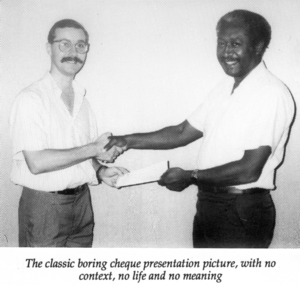 Always remember that you can move - not only from side to side, and backwards and forwards, but up and down, too. Your knees bend. Try kneeling down, or even lying down; try standing on a chair. See what a difference this makes to your picture.
Always remember that you can move - not only from side to side, and backwards and forwards, but up and down, too. Your knees bend. Try kneeling down, or even lying down; try standing on a chair. See what a difference this makes to your picture.
Remember, too, that the people in your picture can move. However, they can only move if you ask them to do so. You will need to take control of the situation and be the boss.
This is not always easy, especially if you are a young journalist and you are photographing important people. You will need to remember that you are a professional person, doing an important job.
If you can take a better photograph of the President outside the building than inside the building, explain to him what you want and ask for his cooperation. If he says no, you have lost nothing; but if he agrees, you will get a better picture. This will please the President as much as it will please you. (See Chapter 16: Interviewing for details of how to deal self-confidently with important people.)
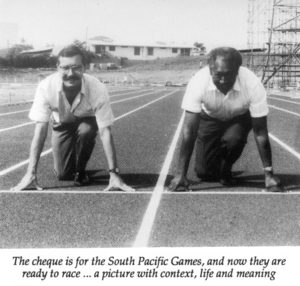 Compare the picture above with the one on the right here. You will see similar posed pictures of presentations - cheques, leaving presents, reports being handed to Parliament etc - in newspapers and magazines all over the world.
Compare the picture above with the one on the right here. You will see similar posed pictures of presentations - cheques, leaving presents, reports being handed to Parliament etc - in newspapers and magazines all over the world.
Posed pictures like the one above, which are simply people handing something to someone else, are quick to set up and easy to take - but they do not grab the readers attention.
By comparison, the photograph on the right took longer to set up and take, but it is a more memorable shot. Your subjects will recognise this and may even ask for a copy to put in a frame on their wall!
When you photograph a group of people, you will need to organise them. Left to themselves, they will stand in a long line, with big spaces between them. Your photograph will then look awful.
Try to arrange different groupings. Bring more important people closer to the camera, so that they will appear bigger than the other people. Try putting tall people behind short people, or get some people to sit and others to stand behind them. Try putting everybody in a crowd, looking up, and stand on a table to photograph them from above.
However you arrange the group, persuade them to stand closer together than they really want to. It is a strange thing, but people look unfriendly in a photograph unless they are very close together, and you will have lots of dead space through the picture if they stand apart. Explain why, and get them to stand so close together that they touch, unless this is entirely socially unacceptable. If it is, bring some people nearer the camera to cover the gaps in the line behind them.
Above all, have ideas for good pictures before you start a job. You can then take control of the situation. If important people try to tell you what to do - "I think we will have one of me behind my desk" - take the picture they want first, and then say: "Can we now try another idea? My editor always likes me to have a selection of shots." Even if you never use the boring picture of the person behind the desk, it was worth the cost of a little film or digital processing time to win the person's confidence in you.
^^back to the top
TO SUMMARISE:
All newspapers should use pictures:
- to make pages more attractive
- to tell the news more clearly
- to let readers know what people, places and things look like
Good news pictures need three qualities:
- to look alive and exciting
- to have a relevant context
- to be meaningful
Bring big stories down to the scale of the individual whenever possible
Point the camera at things which people choose not to see
Keep your sense of humour
Take a variety of pictures of each story:
- more than one picture idea
- a choice of horizontal and vertical for each idea
- several shutter speed and aperture settings for each shot
- try not to use flash; always try at least one shot with available light
This is the end of the first part of this two-part section on news pictures. If you now want to read on, follow this link to the second section, Chapter 47: Captions and graphics in news pictures
^^back to the top

